SI Fantasy analyst Shawn Childs provides his read on this year's crop of NFL Draft talent at the running back position
Top Prospects by Position
1. Najee Harris, Alabama
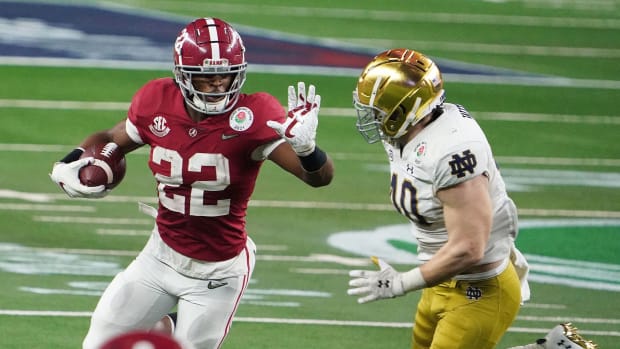
The success of Derrick Henry in the NFL can only increase the potential draft value of Harris. He comes with a big back mold (6’1” and 230 lbs.) with an excellent foundation in speed (4.45 forty). Over his final two seasons at Alabama, Harris gained 3,419 combined yards on 530 touches with 50 touchdowns and 70 catches.
From an NFL perspective, there is a lot to like with the potential upside with Harris. He runs with power plus shows enough wiggle to make defenders miss in space. His feel for the passing game looks to be a win for any team while expecting him to upgrade the scoring on the ground in the red zone. Harris worked hard for his yards, which is what he’ll face at the next level.
A fantasy owner should think of Le'Veon Bell as far as yards and catches. Harris will be a much better scoring threat. A team with a good defense that wants to run a ball-control offense should have Harris on their draft board in 2021.
His ideal fit would be in Pittsburgh.
2. Travis Etienne, Clemson
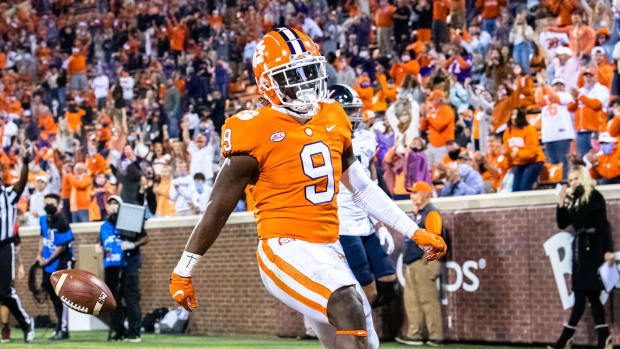
After dominating in the run game for Clemson in 2018 (204/1,658/24) and 2019 (207/1,614/19) while averaging almost eight yards per carry, Etienne had a more challenging time finding open space at the second level of the defense last year (168/914/14 – 5.4 yards per rush). He compensated for this shortfall by upping his value in the passing game (48/588/2). Over the last two years, he proved to be more than worthy as a pass-catcher (85/1,020/6).
Etienne played in a high-scoring offense that allowed him to make big plays up the middle or outside. His vision and feel for play development helped him find the needed space to beat weaker defenses for long touchdowns. Etienne offered a drop step in the open field that led to catching some defenders flat-footed, creating the space to finish runs on the outside with touchdowns. Defenders had a tough time bringing him down with arm and half body tackles. When turning upfield, his speed is almost deceiving, which lets Etienne blow by tacklers who take poor ankles.
His next step in his development will be proving his worth in pass protection and showing the ability to make the proper reads on blitzes. Last year Etienne had a four-game stretch with a fumble (three lost), but he only had four fumbles over his previous three seasons in college. His speed projects to be close to 4.40 in the forty-yard dash.
Etienne should hit the ground running in his first season in the NFL. His three-down style will be a home run if he lands in an offense that already has a high-scoring structure at quarterback and wide receiver.
My best bet is Etienne landing in Miami, New York Jets, or Atlanta.
3. Javonte Williams, North Carolina
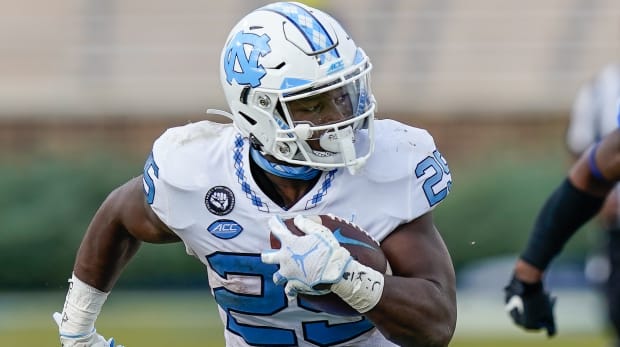
The Tar Heels used Williams in a split role over the last two seasons, leading to 2,554 combined yards with 28 touchdowns and 42 catches. He played at the highest level in 2020 (1,445 combined yards with 22 touchdowns and 25 catches).
Williams has a chain-mover feel while relying on his power and fight to finish off carries. He runs with a smooth rhythm while waiting for a hole to open. Once Williams sees daylight, his acceleration pushes into the second level of the defense. He won’t hit on many long touchdowns, but his short-area quickness plays well. Williams shows plenty of grit, and his style should wear defenses down. Despite a limited role as a receiver, he projects well in the passing game while having the smarts to pick up an NFL offense on all downs.
I sense some of Frank Gore’s traits in his game. Williams has a winning feel, and I expect him to do the dirty work in the run game. He’ll bring punch after punch on his runs, which in turn leads to productive showings on most days.
I could see him finding a home in Seattle on draft day.
4. Kenneth Gainwell, Memphis
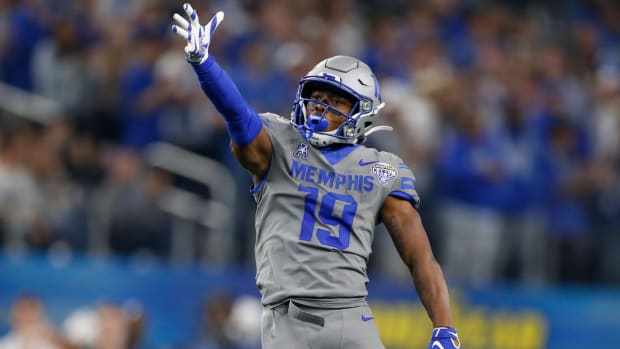
After a minimal opportunity (143 combined yards with one touchdown and six catches) in his red-shirt freshman season, Gainwell excelled in 2019 once given the keys to Memphis’s running back job. He finished with 2,059 combined yards with 16 touchdowns and 51 catches. Gainwell followed in the footsteps of Darrell Henderson and Tony Pollard, who also shined for the Tigers.
Gainwell fits the scatback profile (5'11" and 190 lbs.) while offering impact speed (sub 4.40 forty-yard dash). His vision and quickness are the critical factors for him to break into the second level of the defense. He follows his blocks well with gas to hit a seam quickly. Over the long field, Gainwell made plenty of big plays in college. In the NFL, faster cornerbacks will slow him in the open field. He plays bigger than his size in pass protection, but Gainwell does need to prove he can handle blitzers at the next level. His pass-catching ability will be his attraction on draft day.
A third-down back with breakaway speed and value in the passing game will be a target on draft day from many NFL teams. Gainwell has a similar skill set as Tony Pollard, but he may very well land in a better situation. Ideally, Gainwell would have the most upside in a spread offense.
5. Rhamondre Stevenson, Oklahoma
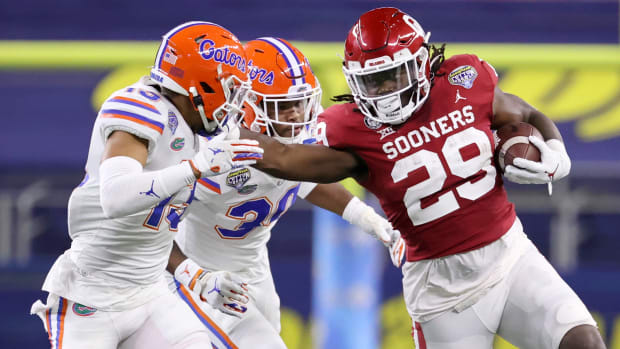
Despite limited touches (193) over two seasons with the Sooners, Stevenson does bring intrigue to an NFL franchise. He had a fullback build (6’0” and 245 lbs.) with surprising speed (4.63 forty). Stevenson finished 1,478 combined yards with 13 touchdowns and 28 catches with Oklahoma. His 2020 season was cut short by five games due to suspension (failed drug test). He started his college career at Cerritos College (2,286 combined yards with 16 touchdowns and 13 catches in 2018).
Stevenson shows nimble feet in tight quarters with better than expected quickness for his size. He’ll finish runs with power and flash stutter steps in space to make defenders miss. Stevenson has sneaky upside as well in the passing game. His ability to feel open space when the quarterback is under duress increases his chances to be on the field on third down.
His path at the next level will start as a short-yardage, goal-line player. If given the right opportunity in a high-scoring offense, Stevenson has the tools to exceed expectations. The key is staying within his body frame and focusing on winning between the tackles.
6. Michael Carter, North Carolina
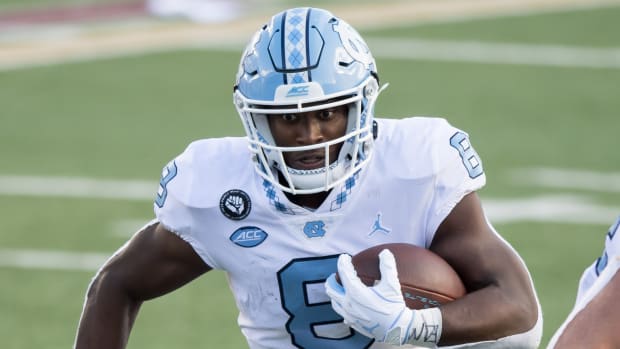
Carter worked as the change of pace back for the Tar Heels. Over his final two seasons, he gained 2,669 yards with 16 touchdowns and 46 catches. He gained 8.0 yards per rush and 10.7 yards per catch in his senior year.
At 5’8” and 199 lbs., Carter has a strong lower half while owning an edge in quickness. His top-end speed came in below expectation when adding in his build.
He runs hard with the vision, power, and elusiveness to reach the second level of the defense. After that, Carter is at the mercy of the open field in front of him. North Carolina used him out of the shotgun on draw plays in the run game. He almost has a misplaced feel in his skill set. I don’t see a difference-maker on third downs in the passing game. Carter will catch passes, but more of his chances may come downfield when matched up with a linebacker.
I see a good player, which is the starting point to be in the NFL. Carter has the talent to succeed, but NFL teams will compare him to the bigger power backs in the draft.
7. Trey Sermon, Ohio State
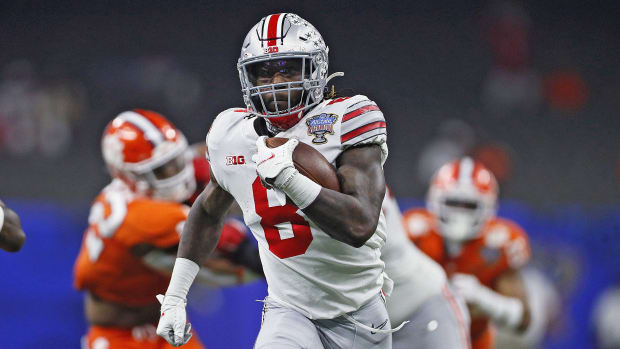
Between four seasons at Oklahoma and Ohio State, Sermon rushed for 2,946 yards on 455 carries with 26 touchdowns. He finished with a minimal role in the passing game (48/486/3). His season ended in 2020 with a shoulder injury in the national championship game. Over his previous three starts, Sermon had 636 rushing yards and four touchdowns on 70 carries.
He profiles as a north/south runner with an occasional flash on the outside. Sermon can break some tackles, but his speed doesn’t separate him from the 2021 running back inventory. His value in the passing game isn’t high enough to command a third-down role in the NFL.
Even with his value trending up late in 2020, I wouldn’t fight for Sermon on draft day. He’ll break some tackles and possibly help an NFL team on early downs, but I don’t trust his ability to stay healthy after battling injuries in 2019 and 2020.
More NFL Draft Coverage:
- Orr: 2021 NFL Draft: AFC Team Needs
- Vrentas: Mock Draft 3.0: Justin Fields Picked Third
- Breer: 20 Things to Know About the Draft
- Rosenberg: The Unrivaled Arrival of Trevor Lawrence
SI Fantasy analyst Shawn Childs provides his read on this year's crop of NFL Draft talent at the running back position
Top Prospects by Position
Quarterbacks | Running Backs | Wide Receivers | Tight Ends
1. Najee Harris, Alabama

The success of Derrick Henry in the NFL can only increase the potential draft value of Harris. He comes with a big back mold (6’1” and 230 lbs.) with an excellent foundation in speed (4.45 forty). Over his final two seasons at Alabama, Harris gained 3,419 combined yards on 530 touches with 50 touchdowns and 70 catches.
From an NFL perspective, there is a lot to like with the potential upside with Harris. He runs with power plus shows enough wiggle to make defenders miss in space. His feel for the passing game looks to be a win for any team while expecting him to upgrade the scoring on the ground in the red zone. Harris worked hard for his yards, which is what he’ll face at the next level.
A fantasy owner should think of Le'Veon Bell as far as yards and catches. Harris will be a much better scoring threat. A team with a good defense that wants to run a ball-control offense should have Harris on their draft board in 2021.
His ideal fit would be in Pittsburgh.
2. Travis Etienne, Clemson

After dominating in the run game for Clemson in 2018 (204/1,658/24) and 2019 (207/1,614/19) while averaging almost eight yards per carry, Etienne had a more challenging time finding open space at the second level of the defense last year (168/914/14 – 5.4 yards per rush). He compensated for this shortfall by upping his value in the passing game (48/588/2). Over the last two years, he proved to be more than worthy as a pass-catcher (85/1,020/6).
Etienne played in a high-scoring offense that allowed him to make big plays up the middle or outside. His vision and feel for play development helped him find the needed space to beat weaker defenses for long touchdowns. Etienne offered a drop step in the open field that led to catching some defenders flat-footed, creating the space to finish runs on the outside with touchdowns. Defenders had a tough time bringing him down with arm and half body tackles. When turning upfield, his speed is almost deceiving, which lets Etienne blow by tacklers who take poor ankles.
His next step in his development will be proving his worth in pass protection and showing the ability to make the proper reads on blitzes. Last year Etienne had a four-game stretch with a fumble (three lost), but he only had four fumbles over his previous three seasons in college. His speed projects to be close to 4.40 in the forty-yard dash.
Etienne should hit the ground running in his first season in the NFL. His three-down style will be a home run if he lands in an offense that already has a high-scoring structure at quarterback and wide receiver.
My best bet is Etienne landing in Miami, New York Jets, or Atlanta.
3. Javonte Williams, North Carolina

The Tar Heels used Williams in a split role over the last two seasons, leading to 2,554 combined yards with 28 touchdowns and 42 catches. He played at the highest level in 2020 (1,445 combined yards with 22 touchdowns and 25 catches).
Williams has a chain-mover feel while relying on his power and fight to finish off carries. He runs with a smooth rhythm while waiting for a hole to open. Once Williams sees daylight, his acceleration pushes into the second level of the defense. He won’t hit on many long touchdowns, but his short-area quickness plays well. Williams shows plenty of grit, and his style should wear defenses down. Despite a limited role as a receiver, he projects well in the passing game while having the smarts to pick up an NFL offense on all downs.
I sense some of Frank Gore’s traits in his game. Williams has a winning feel, and I expect him to do the dirty work in the run game. He’ll bring punch after punch on his runs, which in turn leads to productive showings on most days.
I could see him finding a home in Seattle on draft day.
4. Kenneth Gainwell, Memphis

After a minimal opportunity (143 combined yards with one touchdown and six catches) in his red-shirt freshman season, Gainwell excelled in 2019 once given the keys to Memphis’s running back job. He finished with 2,059 combined yards with 16 touchdowns and 51 catches. Gainwell followed in the footsteps of Darrell Henderson and Tony Pollard, who also shined for the Tigers.
Gainwell fits the scatback profile (5'11" and 190 lbs.) while offering impact speed (sub 4.40 forty-yard dash). His vision and quickness are the critical factors for him to break into the second level of the defense. He follows his blocks well with gas to hit a seam quickly. Over the long field, Gainwell made plenty of big plays in college. In the NFL, faster cornerbacks will slow him in the open field. He plays bigger than his size in pass protection, but Gainwell does need to prove he can handle blitzers at the next level. His pass-catching ability will be his attraction on draft day.
A third-down back with breakaway speed and value in the passing game will be a target on draft day from many NFL teams. Gainwell has a similar skill set as Tony Pollard, but he may very well land in a better situation. Ideally, Gainwell would have the most upside in a spread offense.
5. Rhamondre Stevenson, Oklahoma

Despite limited touches (193) over two seasons with the Sooners, Stevenson does bring intrigue to an NFL franchise. He had a fullback build (6’0” and 245 lbs.) with surprising speed (4.63 forty). Stevenson finished 1,478 combined yards with 13 touchdowns and 28 catches with Oklahoma. His 2020 season was cut short by five games due to suspension (failed drug test). He started his college career at Cerritos College (2,286 combined yards with 16 touchdowns and 13 catches in 2018).
Stevenson shows nimble feet in tight quarters with better than expected quickness for his size. He’ll finish runs with power and flash stutter steps in space to make defenders miss. Stevenson has sneaky upside as well in the passing game. His ability to feel open space when the quarterback is under duress increases his chances to be on the field on third down.
His path at the next level will start as a short-yardage, goal-line player. If given the right opportunity in a high-scoring offense, Stevenson has the tools to exceed expectations. The key is staying within his body frame and focusing on winning between the tackles.
6. Michael Carter, North Carolina

Carter worked as the change of pace back for the Tar Heels. Over his final two seasons, he gained 2,669 yards with 16 touchdowns and 46 catches. He gained 8.0 yards per rush and 10.7 yards per catch in his senior year.
At 5’8” and 199 lbs., Carter has a strong lower half while owning an edge in quickness. His top-end speed came in below expectation when adding in his build.
He runs hard with the vision, power, and elusiveness to reach the second level of the defense. After that, Carter is at the mercy of the open field in front of him. North Carolina used him out of the shotgun on draw plays in the run game. He almost has a misplaced feel in his skill set. I don’t see a difference-maker on third downs in the passing game. Carter will catch passes, but more of his chances may come downfield when matched up with a linebacker.
I see a good player, which is the starting point to be in the NFL. Carter has the talent to succeed, but NFL teams will compare him to the bigger power backs in the draft.
7. Trey Sermon, Ohio State

Between four seasons at Oklahoma and Ohio State, Sermon rushed for 2,946 yards on 455 carries with 26 touchdowns. He finished with a minimal role in the passing game (48/486/3). His season ended in 2020 with a shoulder injury in the national championship game. Over his previous three starts, Sermon had 636 rushing yards and four touchdowns on 70 carries.
He profiles as a north/south runner with an occasional flash on the outside. Sermon can break some tackles, but his speed doesn’t separate him from the 2021 running back inventory. His value in the passing game isn’t high enough to command a third-down role in the NFL.
Even with his value trending up late in 2020, I wouldn’t fight for Sermon on draft day. He’ll break some tackles and possibly help an NFL team on early downs, but I don’t trust his ability to stay healthy after battling injuries in 2019 and 2020.
More NFL Draft Coverage:


0 Comments